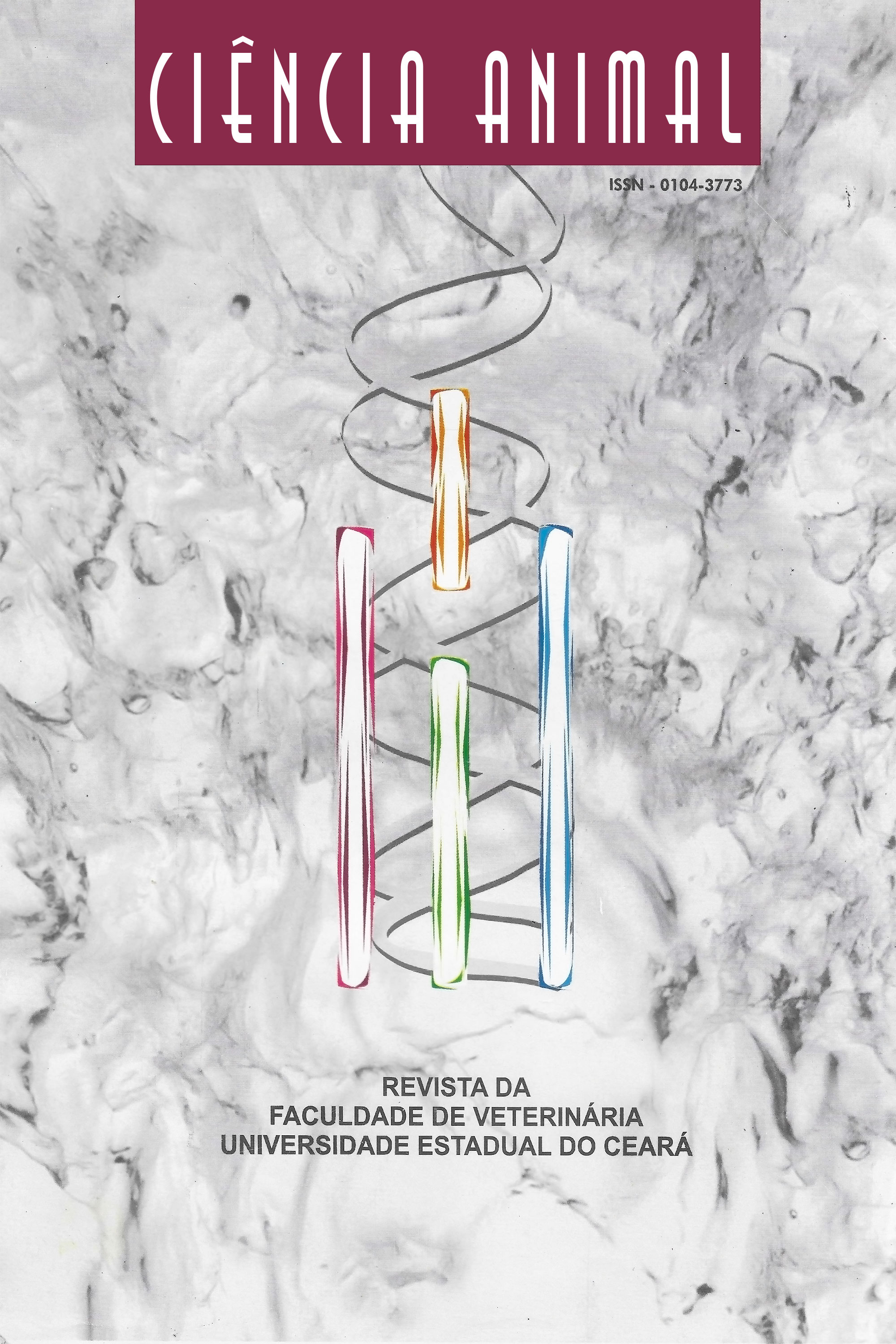AÇÃO ANTIPARASITÁRIA DA IVERMECTINA, MOXIDECTINA E PIPERAZINA CONTRA Parascaris spp. EM POTROS NO SUL DO RIO GRANDE DO SUL, BRASIL
Palavras-chave:
Anti-helmíntico, Equinocultura, Cavalos, TRCOFResumo
Parascaris spp. são os parasitas mais perigosos dos potros e estão relacionados ao baixo crescimento, perda de peso, cólicas e morte após impactação ou perfuração intestinal. A redução da eficácia dos antiparasitários tornou-se uma séria ameaça à saúde animal e há poucas perspectivas de surgimento de um novo anti-helmíntico para equinos. Portanto, objetivou-se avaliar a eficácia dos princípios ativos utilizados no controle de ascarídeos em potros crioulos, em uma propriedade localizada no sul do Rio Grande do Sul, Brasil. Foram utilizados os resultados da técnica de Gordon e Whitlock de 12 amostras de fezes de potros, que foram coletadas na data da administração do antiparasitário e 14 dias após. A avaliação da eficácia dos princípios ativos foi realizada por meio do Teste de Redução de Contagem de Ovos nas Fezes (TRCOF). Todos os anti-helmínticos utilizados falharam contra Parascaris spp. e não devem ser usados para controlar as infecções desses helmintos na população estudada, além disso, há uma resistência generalizada dos ascarídeos contra as avermectinas. Os resultados também mostram que outras práticas de manejo devem ser implementadas na propriedade, na tentativa de reduzir as infecções por esses helmintos.
Referências
AUSTIN, S.M.; DIPIETRO, J.A.; FOREMAN, J.H.; BAKER, G.J.; TODD, K.S.J. Parascaris equorum infections in horses. Compendium on Continuing Education for the Practising Veterinarian, v.12, n.8, p.1110-1119, 1990.
CANEVER, R.J. Diagnóstico da resistência anti-helmíntica em cíatostomineos de equinos por meio de testes in vivo e in vitro, 2012. 99p. (Dissertação de Mestrado em Ciências Veterinárias). Universidade Federal do Paraná. Setor de Ciências Agrárias. Programa de Pós-Graduação em Ciências Veterinárias, 2012.
CAZAPAL-MONTEIRO, V.; ARIAS, M.; SUÁREZ, J.; RODRIGUES, M.I.; FRANCISCO, I.; CORTIÑAS, F.J.; MADEIRA DE CARVALHO, L.M.; SÁNCHEZ-ANDRADE, R.; PAZ-SILVA, A. Effect of Duddingtonia flagrans chlamydospores on the controle of parasite infection in grazing horses. Forages and Grazing in Horse Nutrition, v.132, n.3/4, p.419-423, 2012.
COOPER, L.G.; CAFFE, G.; CERUTTI, J.; NIELSEN, M.K.; ANZIANI, O.S. Reduced efficacy of ivermectin and moxidectin against Parascaris spp. in foals from Argentina. Veterinary Parasitology: Regional Studies and Reports, v.20, p.1-3, 2020.
COSTA, E.; DIEHL, G.N.; SANTOS, D.V.; SILVA, A.P.S.P. Panorama da equinocultura no Rio Grande do Sul. Secretaria Estadual da Agricultura, Pecuária e Abastecimento. Informativo Técnico n.5, 2014. Available in: https://www.agricultura.rs.gov.br/upload/ arquivos/201612/02101333-inftec-50-panorama-da-equinocultura-no-rio-grande-do-sul.pdf. Accessed in: 07 jun. 2022.
CRAIG, T.M.; DIAMOND, P.L.; FERWERDA, N.S.; THOMPSON, J.A. Evidence of ivermectin resistance by Parascaris equorum on a Texas horse farm. Journal of Equine Veterinary Science, v.27, n.2, p.67-71, 2007.
DIPIETRO, J.A.; LOCK, T.F.; TODD, K.S.; REUTER, V.E. Evaluation of ivermectin paste in the treatment of ponies for Parascaris equorum infections. Journal of the American Veterinary Medical Association, v.190, n.9, p.1181-1183, 1987.
DRUDGE, J.H.; LYONS, E.T. Internal Parasites of Equids with Emphasis on Treatment and Control. 1. ed. Hoechst-Roussel AgriVeterinary Company, 1986.
FRENCH, D.D.; KLEI, T.R.; TAYLOR, H.W.; CHAPMAN, M.R.; WRIGHT, F.R. Efficacy of ivermectin in the oral paste formulation against naturally acquired adult and larval stages of Parascaris equorum in pony foals. American Journal of Veterinary Research, v.49, n.7, p.1000-10003, 1988.
GORDON, H.M.C.L.; WHITLOCK, H.V. A new technique four counting nematode eggs in sheep faeces. Journal of Scientific and Industrial Research, v.12, n.1, p.50-2, 1939.
KAPLAN, R.M. Drug resistance in nematodes of veterinary importance: a status report. Trends in Parasitology, v.20, n.10, p.477-481, 2004.
LIND, E.O.; CHRISTENSSON, D. Anthelmintic efficacy on Parascaris equorum in foals on Swedish studs. Acta Veterinaria Scandinavica, v.51, n.45, p.1-4, 2009.
LYONS, E.T.; DORTON, A.R.; TOLLIVER, S.C. Evaluation of activity of fenbendazole, oxibendazole, piperazine, and pyrantel pamoate alone and combinations against Ascarids, Strongyles, and Sstrongyloides in horse foals in field tests on two farms in Central Kentucky in 2014 and 2015. Veterinary Parasitology: Regional Studies and Reports, v.3/4, p.23-26, 2016.
MAPA. Ministério da Agricultura, Pecuária e Abastecimento. Revisão do Estudo do Complexo do Agronegócio do Cavalo, 2016. Available in: http://www.agricultura.gov.br /assuntos/camarassetoriaistematicas/documentos/camaras/equideocultura/anosanteriores/revisaodoestudodocomplexodoagronegocio-docavalo. Accessed in: 07 jun. 2022.
MOLENTO, M.B. Resistência de helmintos em ovinos e caprinos. Revista Brasileira de Parasitologia Veterinária, v.13, n.1, p.82-87, 2004.
MOLENTO, M.B. Resistência parasitária em helmintos de equídeos e propostas de manejo. Ciência Rural, v.35, n.6, p.1469-1477, 2005.
MOLENTO, M.B.; ANTUNES, J.; BENTES, R.N.; COLES, G.C. Anthelmintic resistant nematodes in Brazilian horses. Veterinary Record, v.162, n.12, p.384-385, 2008.
NIELSEN, K.M.; REINEMEYER, C.R. Handbook of Equine Parasite Control. 2. ed. Hoboken, NJ, 2018.
REICZIGEL, J.; FÖLDI, J.; OZSVÁRI, L. Exact confidence limits for prevalence of a disease with an imperfect diagnostic test. Epidemiology and Infection, v.138, n.11, p.1674-1678, 2010.
REINEMEYER, C.R. Diagnosis and Control of Anthelmintic-Resistant Parascaris Equorum. Parasites & Vectors, v.2, n.8, p.1-8, 2009.
REZENDE, A.S.C.; SAMPAIO, I.B.M.; LEGORRETA, G.L.; MOREIRA, D.C.A. Efeito de dois diferentes programas nutricionais sobre o desenvolvimento corporal de potros Mangalarga Marchador. Revista Brasileira de Zootecnia, v.29, n.2, p.495-501, 2000.
SOUZA, F.A.C.; FERNANDES, T.J.; MOURA, R.S.; MEIRELLES, S.L.C.; RIBEIRO, R.A.; CUNHA, F.O.; MUNIZ, J.A. Nonlinear modeling growth body weight of Mangalarga Marchador horses. Ciência Rural, v.47, n.4, p.1-6, 2017.
Downloads
Publicado
Como Citar
Edição
Seção
Licença

Este trabalho está licenciado sob uma licença Creative Commons Attribution 4.0 International License.



